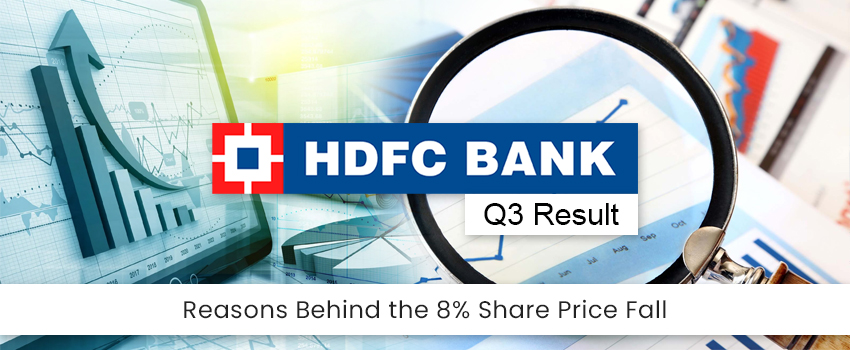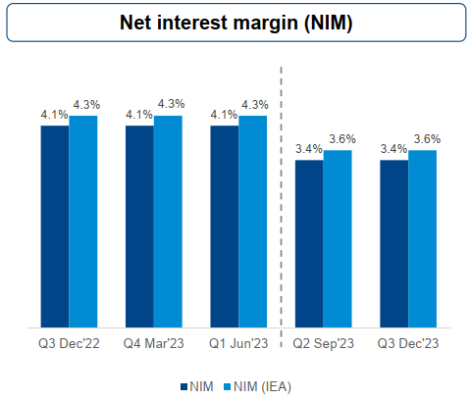Despite HDFC Bank’s stable Q3FY24 performance, the bank’s stock faced an 8% decline. The growth in advances and deposits, along with a healthy RoA and RoE, highlighted the bank’s underlying strength. However, the bank saw an increased cost of borrowing, impacting NIMs, and a slowdown in CASA growth, posing short-term challenges.
Result Updates:
- The Bank’s consolidated net revenue grew to Rs. 717.7 bn for Q3FY24 from Rs. 336.2 billion in Q3 FY23 (Pre-merger).
- Advances growth of Rs. 1.1 tr (↑4.9%)
- Deposits increased by Rs. 0.4 tr (↑1.9%)
- Retail deposits grew Rs. 0.5 tr (↑2.9%)
- RoA of 2.0% and RoE of 15.8% in the current quarter.
- Consolidated EPS of Rs. 22.7 for the quarter and BVPS stood at Rs. 576.
- Capital adequacy ratio came in at 18.4%
- The consolidated PAT came in at Rs. 172.6 bn, up 35.9%, over Q3 FY23.
PAT was impacted by Rs. 1200 Cr provisioning done for the AIF exposure as per recent RBI guidelines, whereas PAT included profit from the Bandhan Bank stake sale that happened in this quarter. Retail advances grew 3.3% QoQ, primarily driven by strong performance in the mortgage business. The company added 908 branches over the last 12 months and 146 branches during the quarter.
How has the merger affected consolidated numbers for HDFC Bank?
HDFC Banks primarily relies on CASA franchise (44% pre-merger and 38% currently), whereas HDFC Limited relies only on borrowing and term deposits. Due to this, the cost of funds for the consolidated entity has increased to 4.9% from 3.5% in Dec 2022. Thus, NIMs have compressed to 3.4% from earlier 4.3%.
After the merger, the Loan to deposit ratio (LDR) for HDFC Bank stands at 110, without accounting for the merger the number stands at 89 from an earlier quarter LDR of 85.
(Source: Company reports, IEA = Interest earning assets)
MoneyWorks4Me Opinion:
Currently, HDFC Bank is facing problems on 2 fronts, pressure on NIMs caused by an increased cost of borrowing post-merger and the decreasing pace of growth in CASA to support the growth in lending. Competition has increased for CASA deposits and HDFC Management is currently not content to grow deposits at the cost of higher deposit rates. This would mean the NIMs which currently stand at 3.4% would need a few more quarters to recover. Management would eventually have to increase the deposit rates to remain competitive.
We feel that this is a 3-4 quarter phenomenon and would not affect the company’s long-term fundamentals. Large-cap banks are fairly valued as against the overall highs that we are currently seeing in the market and thus there exists decent valuation comfort. We recommend investors stay invested and can also increase allocation if they are under-allocated in Banks.
Best Stocks From:
Top 10 Stocks in India Best EV Stocks in India Screener Alpha Cases Best 5G Stocks in India Top AI Stocks in India Best Drone Stocks in India Best Defence Stocks in India Top 10 Infrastructure Stocks in India Best Fintech Stocks in India Best Manufacturing Stocks in India Best Liquor Stocks in India
Need help on Investing? And more….Puchho Befikar
Why MoneyWorks4me | Call: 020 6725 8333 | Ebook | WhatsApp: 9860359463
*Investments in the securities market are subject to market risks. Read all the related documents carefully before investing.
*Disclaimer: The securities quoted are for illustration only and are not recommendatory












